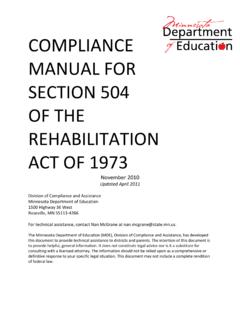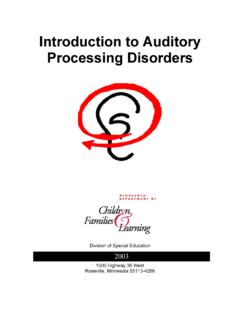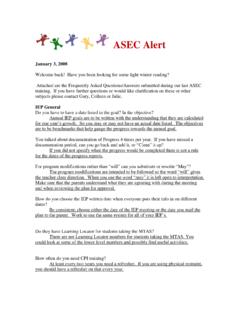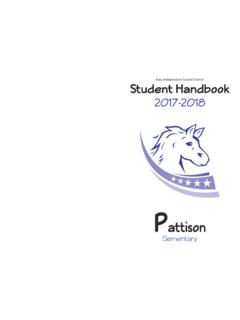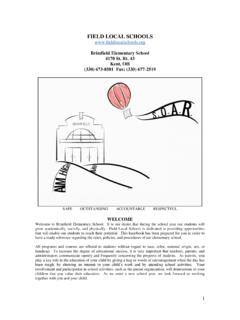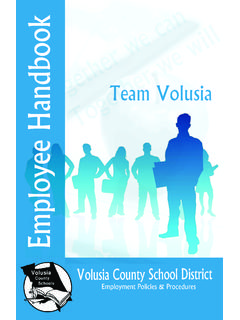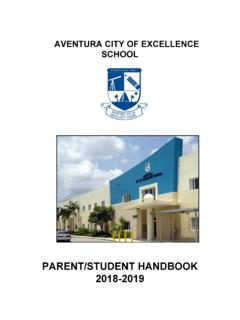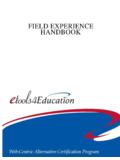Transcription of Special Education Paraprofessional Handbook - ASEC
1 Special Education Paraprofessional Handbook Area Special Education Cooperative August 2003. 1. Special Education Paraprofessional Handbook Table of Contents Chapter 1 .. 5. Philosophical, Historical and Legal Foundations of Education .. 5. Individualized Programming .. 6. Diversity and Learning .. 6. Role Clarification: The Paraprofessional and the Supervising Teacher .. 7. Role of the Paraprofessional .. 8. Confidentiality and It's Application .. 12. Chapter 2 .. 14. Characteristics of Learners .. 14. Autism .. 14. 14. Deaf/Hard of Hearing .. 14. Developmental Delay .. 14. Developmentally Adapted Physical Education : Special 15.
2 Emotional Behavioral Disorder .. 15. Developmental Cognitive Delay (DCD).. 15. Severely Multiply 16. Specific Learning Disability .. 16. Speech or Language Impairment .. 17. Traumatic Brain Injury .. 17. Visually Impaired .. 18. Chapter 3 .. 19. Assessment and Evaluation .. 19. Observing and Keeping Good Data .. 19. Chapter 4 .. 22. Instructional Content and 22. Motivating 22. Classroom Accommodations .. 24. Questions about Adapting Curriculum and Instruction .. 24. Types of 26. Special Responsibilities .. 26. Physical and Occupational Therapy .. 27. Chapter 5 .. 28. Supporting the Teaching and Learning 28.
3 Classroom Management .. 28. Health Precautions and First Aid .. 29. 31. Child Abuse and Neglect .. 32. Reporting 33. Chapter 6 .. 35. Facilitating Positive Student Behavior and Social Interaction Skills .. 35. Behavior 36. Area Special Education Cooperative 2 8/01. Special Education Paraprofessional Handbook Chapter 7 ..39. Communication and Collaborative 39. Teaming/Collaborations ..39. Conflict Strategies: What are you like? ..41. Chapter 8 ..44. Professionalism and Ethical Practices .. 44. Professional Ethics ..44. Appendix A ..46. District Policies/Procedures .. 47. Where Can I find _____?? .. 50.
4 What Should I Do If_____?? .. 50. Student Handbook Item 52. Teaming/Collaboration .. 54. Administrative 57. Special Education Paraprofessional Job Description .. 58. Appendix school 59. District 59. Emergency Calling Tree .. 59. school Crisis Policy .. 59. District Accident Report .. 59. Paraprofessional Performance Evaluation .. 59. Appendix Resources:.. 60. Appendix D ..61. Specialized Competencies for Minnesota 61. Area Special Education Cooperative 3 8/01. Special Education Paraprofessional Handbook Welcome! As a newly hired Paraprofessional you are entering into an important and challenging role within the school system.
5 The role of paraprofessionals in educational environments has changed dramatically over the past several years. The increased use of educational paraprofessionals is due to federal legislation such as Chapter 1 of the Improving American Schools Act (IASA) and the Individuals with Disabilities Education Act ( 101-457) of 1990 commonly referred to as IDEA. The legislation emphasized the inclusion of students with disabilities into the regular classroom and community environments and increased the need for and use of paraprofessionals . Along with the increased need for paraprofessionals came the need for training and professional development.
6 In 1998 Minnesota established core competencies that paraprofessionals hired to work in schools must acquire or demonstrate within the first 45 days of being hired. These core competencies, which form the basis of this Handbook , are designed to provide the new Paraprofessional with the basic skills and knowledge required to carry out this very important job. In addition to the core competencies, each school has its own policies and procedures such as evaluation practices, emergency procedures, employment policies and staff conduct guidelines. It is important to be familiar with the policies and procedures of the district in order to perform the job in an orderly, appropriate, and efficient manner.
7 This Handbook is intended to be a guide that can be added to as additional training is acquired. The Area Special Education Cooperative (ASEC) assists in providing ongoing training and support to paraprofessionals of the member school districts. The training is provided through a variety of mediums such as inservices, web based instruction, and one-on-one support. Area Special Education Cooperative 4 8/01. Special Education Paraprofessional Handbook Chapter 1. Philosophical, Historical and Legal Foundations of Education Historically individuals with disabilities were not valued members of the community.
8 Sometimes, Special asylums were built for people who were disabled. Often conditions in these institutions were dehumanizing, filthy and crowded. There is little evidence that people in these institutions were given skills or Education that would enable them to cope with the world and become members of the greater community. Much of the lack of Education occurred because it was believed that these individuals were not able to learn like other people and that it would be a waste of time and money to help them learn. In recent times as early as the 1970's, prior to Public Law 94-142 ( Education of All Handicapped Children Act), children with Special needs often continued to be excluded from the public Education system or if included, they were often segregated from their peers in separate classrooms or schools.
9 This practice is no longer acceptable. Today, with the reauthorization of 94-142, now called IDEA (Individuals with Disabilities Education Act), students with disabilities are now an integral part of the regular school environment. This legislation emphasized the inclusion of children with disabilities into the regular classroom and community environments, and increased the need for and use of paraprofessionals . When that is not possible, children are to be educated in the "least restrictive environment" appropriate for the child. Federal law, as well as State mandated practices, have established procedures to assure that to the maximum extent appropriate, students with disabilities are educated with non-disabled students.
10 Special classes, separate schools, or other removal of students with disabilities from the regular educational environment occur only when the nature or severity of the disability is such that Education in regular classes, with the use of supplementary aids and services, cannot be achieved satisfactorily. Research supports that children with disabilities benefit from inclusive instruction within the regular classroom environment. For children with moderate to severe handicaps, inclusion can increase social interaction between disabled and non-disabled children. Inclusion can increase social acceptance by peers and provide disabled students with appropriate behavior models.
